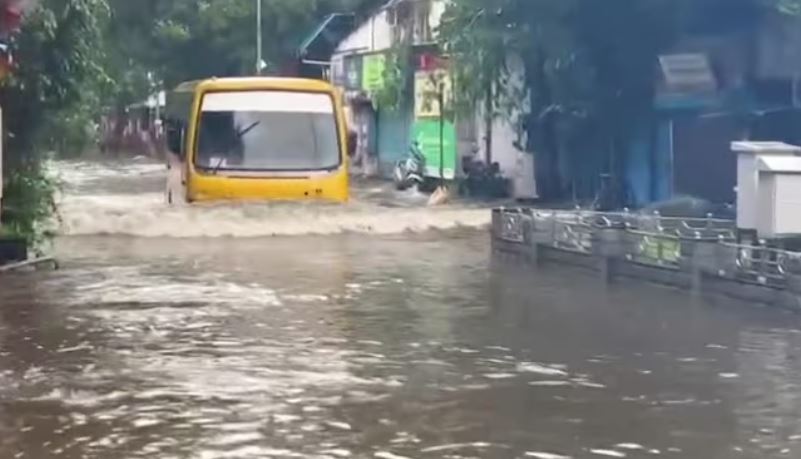Overview of the Situation
The bustling city of Mumbai recently encountered severe weather disruptions, causing significant impacts on daily life and transportation. On Monday morning, the city was hit by heavy rainfall, leading to widespread waterlogging and traffic snarls. The Brihanmumbai Municipal Corporation (BMC) reported that certain areas received over 300 mm of rain between 1 am and 7 am, causing substantial disruptions at Chhatrapati Shivaji Maharaj International Airport (CSMIA). Airlines, including Air India, SpiceJet, IndiGo, and Vistara, took to social media to alert passengers about the delays and cancellations.
Impact on Air Travel
Flight Cancellations and Delays
The intense rainfall in Mumbai severely affected flight operations at CSMIA. Passengers experienced numerous delays and cancellations due to the adverse weather conditions. Airlines were proactive in informing travelers about the situation via social media platforms. Air India advised passengers to depart early for the airport due to slow-moving traffic and waterlogged streets. The airline also recommended that travelers check their flight status before heading to the airport to avoid any inconveniences.
Airline Responses and Recommendations
IndiGo and Vistara also issued statements on social media, urging passengers to plan their journeys to the airport with extra time. IndiGo provided options for passengers to opt for alternate flights or claim a full refund due to the disruptions. Vistara warned about heavy traffic congestion en route to the airport and advised customers to allow more time for their travel.
SpiceJet echoed similar sentiments, advising passengers to stay updated on their flight status before leaving for the airport. The BMC predicted further heavy rainfall throughout the day, exacerbating the situation.
Broader Implications of the Heavy Rains
Disruptions in Daily Life
The unexpected heavy rainfall caused massive waterlogging across Mumbai, affecting daily commutes and public transportation. The BMC and the India Meteorological Department (IMD) issued alerts, warning residents about continued rainfall and potential disruptions. The IMD forecasted light to moderate rainfall over the city for the next few hours, keeping the city on high alert.
Public Transportation Challenges
The BMC announced that the entire civic machinery was actively working in the field to manage the situation. The Brihanmumbai Electric Supply and Transport (BEST) service reported that several bus routes had to be diverted due to severe waterlogging. This added to the transportation woes, as commuters faced challenges reaching their destinations.
Emergency Response and Measures
NDRF Deployment
In response to the heavy rainfall and its potential hazards, the National Disaster Response Force (NDRF) deployed teams across various parts of Maharashtra. These teams were stationed in areas such as Thane, Vasai/Palghar, Mahad/Raigad, Chiplun/Ratnagiri, Kolhapur, Sangli, Satara, Ghatkopar, Kurla, and Sindhudurg. The NDRF’s presence aimed to mitigate any untoward incidents and provide swift responses in flood-like situations.
Strategic Actions in Mumbai
In Mumbai, three regular NDRF teams were deployed in Andheri and one team in Nagpur. These teams were put into action to avert any potential crises and to ensure an appropriate response in case of emergencies. Their efforts were crucial in managing the flood-prone areas and providing relief to affected residents.
Long-Term Implications and Preparedness
Need for Improved Infrastructure
The recurring issue of heavy rainfall and subsequent flooding in Mumbai highlights the need for improved infrastructure and better urban planning. The city’s drainage system and public transport infrastructure require significant upgrades to handle such extreme weather conditions more effectively. Enhancing these systems can help mitigate the impact of heavy rains and prevent widespread disruptions in the future.
Climate Change Considerations
The increasing frequency and intensity of extreme weather events in Mumbai and other parts of India also underscore the broader implications of climate change. Policymakers and city planners need to incorporate climate resilience into urban development plans. This includes investing in sustainable infrastructure, enhancing early warning systems, and ensuring better preparedness for natural disasters.
Summary of Key Learning Points
| Key Points | Description |
|---|---|
| Impact on Air Travel | Heavy rains in Mumbai caused significant disruptions at CSMIA, affecting flights and leading to cancellations and delays. |
| Airline Responses | Airlines like Air India, IndiGo, and Vistara informed passengers via social media and recommended early departure and checking flight status. |
| Daily Life Disruptions | The heavy rainfall led to waterlogging and traffic congestion, affecting daily commutes and public transportation. |
| Emergency Measures | The NDRF deployed teams across Maharashtra to manage the situation and provide swift responses to emergencies. |
| Infrastructure Needs | The recurring flooding issue highlights the need for better urban planning and improved drainage systems in Mumbai. |
| Climate Change Considerations | The events underscore the importance of incorporating climate resilience into urban development to handle extreme weather. |
Soumya Smruti Sahoo is a seasoned journalist with extensive experience in both international and Indian news writing. With a sharp analytical mind and a dedication to uncovering the truth, Soumya has built a reputation for delivering in-depth, well-researched articles that provide readers with a clear understanding of complex global and domestic issues. Her work reflects a deep commitment to journalistic integrity, making her a trusted source for accurate and insightful news coverage.



